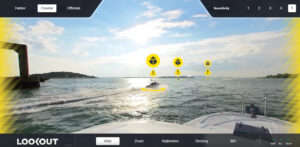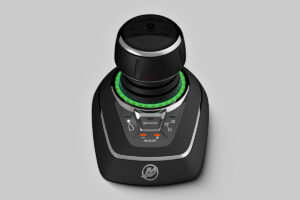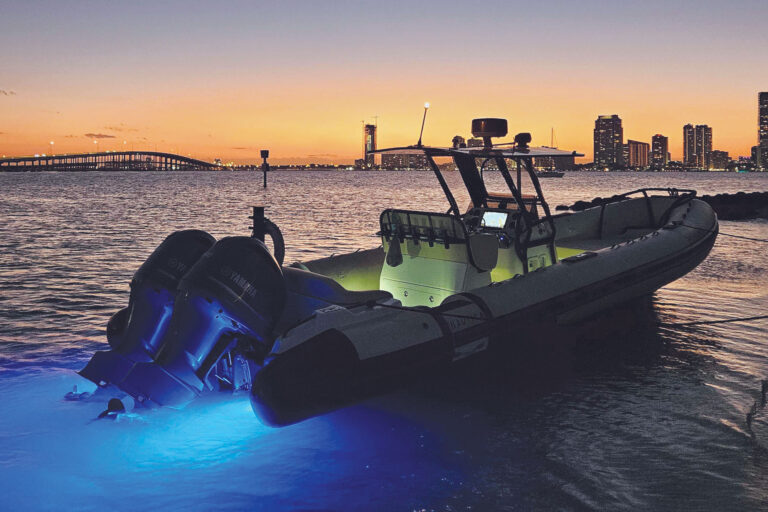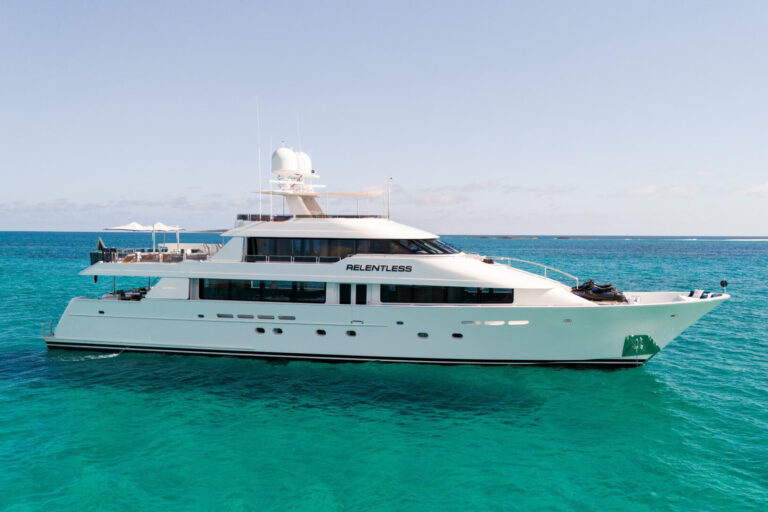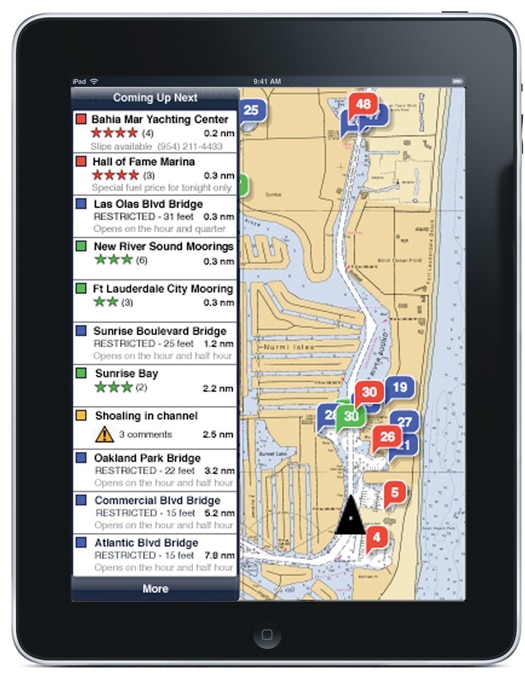
Tablets
I’m writing soon after Apple CEO Steve Jobs introduced the iPad, and the cyberpundits and tech reviewers are being critical. It’s true that there are details of the device that may not be optimal, but I laugh about the complaint that it’s “nothing but a big iPhone,” because I suspect that’s exactly the device that will be welcomed aboard many a yacht. I’ve never seen a consumer electronics product earn such wide and deep boater love as the iPhone, and on a boat many of its most attractive features will benefit from the bigger screen, while the actual phone component won’t be much missed.
This is a subject I can discuss from personal experience. For nearly a year now I’ve been using one of the 75 million iPhones already sold, and have appreciated it most when aboard my 37-foot cruising boat. Many of my uses are commonplace—like listening to stored music and podcasts through Gizmo’s stereo system, reading and replying to e-mail, managing the comments on my website, and browsing for news—but they’re all usually harder to do on the boat than in my wired-to-the-hilt home and office. And while midcoast Maine may only have AT&T’s slower Edge cellular data service, not 3G, it works okay and covers a lot more area than the occasional WiFi connections I can make with the boat’s laptop.
The 1.5-pound, 9.5-by-7.5-inch iPad (www.apple.com) may not be very handy for use while in a car or standing in an airport, but there are numerous places I can picture using one aboard. They include the saloon settee and chart table, cockpit, and flying bridge seating in some conditions—screen brightness is still uncertain, but there will be all sorts of waterproof covers available—and, last but not least, my berth. It’s a somewhat embarrassing image to share, but while cruising last summer I did in fact enjoy retiring with my iPhone so that I could read the latest newspapers and blogs (without the need for a reading light I haven’t yet converted to LED), and check the weather without arising.
The iPad is not only designed to be a real eReader, but also marks Apple’s entry into the digital book business. Soon iTunes users will be able to purchase and download literature as easily as all the audio content that helped drive the iPod and iPhone success stories. And, of course, iTunes video content will be much more watchable on the iPad’s 9.7-inch high-resolution screen, not to mention the larger boat screen you might hook it up to. Imagine then loading a cruising vacation’s worth of reading, listening, and viewing material on the svelte iPad plus being able to add fresh items like the New York Times whenever you’ve got a cellular or WiFi Internet connection. Indeed, one of Jobs’s primary iPad demos was a version of the Times that looked strikingly like the printed paper except that he could touch-link fluidly through it and some normally still photos could be tapped into fullscreen videos. Keeping all manner of media organized aboard may be enough to justify an iPad.
Not that the iPad is wickedly expensive, starting at $500 for the base WiFi-only model with 16 gigabytes of memory. That’s approximately room enough for a thousand tunes, hundreds of illustrated books and magazines, and dozens of TV shows and/or vidcasts, but if, say, you want to enjoy iTunes expanding movie collection, consider $600 for the 32-gig model, $700 for 64. WiFi might work well for a yacht with a built-in Internet feed or a yacht with one of the new self-contained cell modems that creates its own WiFi hotspot—a neat feature that’s purportedly coming to cell phones. But an extra $130 puts a 3G data modem in any iPad model, which makes it eligible for a $30 per month unlimited AT&T data plan that can be stopped and started at will, a possibly significant boon for seasonal cruisers.
While the iPad looks to be a very yacht-friendly content-delivery gadget—and, yes, it will also support touch-enabled productivity programs like word processing, spreadsheets, and presentations—the most exciting thing about boating with a big-screen iPhone may be what it will mean for the growing number of marine applications. Although Apple only started letting developers write programs for the iPhone, and distribute them via iTunes, in mid-2008, there are over 140,000 such programs today and over 3 billion copies have been downloaded. “Phenomenal” is an understatement for this self-reinforcing surge of creativity and user interest, and it applies to boating utilities and pleasures as much as it does to addictive games.
Memory-Map will soon join iNavX, Navionics Mobile, Navimatics, and Fly-to- Map with an interesting iPhone charting program, all of which will work on the iPad when it ships in April, at least in a 480-by- 320 pixel window, and all which will be considerably richer when optimized for the iPad’s 1024-by-768 resolution, drop-down menus, and other interface enhancements. As I’ve discussed on my blog, these apps are primarily suited for backup navigation and planning, with the significant advantage of an Internet connection, but that’s not the whole story. While many users term Navionics Mobile a “no-brainer” due to its gift-like pricing and easy track-sharing features, iNavX is the current king of the hill in terms of serious navigation because it can use the Internet to fetch weather overlays and what may be the world’s largest selection of charts easily, and it can use a yacht’s local WiFi to access its instruments, thus getting depth, wind, and a level of GPS much superior to what’s built into the iPad or iPhone.
Taking advantage of its WAN and LAN (Wide and Local Area Networks) connectivity, InteliSea developed an iPhone interface to its megayacht monitoring systems that can be used by guests and crews offshore and owners anywhere. Its detailed screens, like mimic panels showing alarm locations, will likely shine on an iPad, and competitor Palladium Systems will no doubt update its iSiMON app to include such detail.
As I write, four AIS-viewing apps are in the mix. Ship Tracking, gTrax, and Fleetmon all differ from Ship Finder in coverage areas, pricing, and features, and some, incidentally, can access online databases of photos, track records, and other info that’s not included in regular AIS transmissions.
KVH already has a control app that connects to a WiFi radio built into its TracVision HD7 satellite TV system, and, given the projected sales of iPads and iPhones, surely other manufacturers will follow. Might some multi-function display developer let you use an iPad as a wireless secondary display, radar included? It’s possible.
There are many ways to access live weather radar on an iPhone, which again will be more useful on a bigger screen, and I could go on and on. But I’m not recommending that you snap up an iPad. Apple does limit a gadget’s peripheral usability for the sake of simplicity. For instance, I can’t run an anchor-watch app from my berth because the iPhone’s Bluetooth wireless, though great for headsets, isn’t yet allowed to talk to a Bluetooth GPS sensitive enough for the task.
I’m sure you could find at least 16 gigabytes of content about how well iPads will or will not work when we actually get to try them, and another 16 on all the other app-phone and tablet development being propelled by the “iPhenomenon.” Consider Google, for instance, with its massive search and mapping resources, and its mobile operating system Android. I’m adopting a wait-and-see attitude. Though if you do buy an iPad, please consider letting me test it, for a few weeks or so.



